Apple's 15-inch Core i5 MacBook Pro: The One to Get?
by Anand Lal Shimpi on April 14, 2010 10:38 PM EST- Posted in
- Mac
- MacBook Pro
- Arrandale
- Core i5
- Laptops
They’re Actually Faster
Benchmarking under OS X isn’t difficult, you just need to get creative. Luckily I’m in dire need of creative outlets so creating OS X benchmarks works for me. I’m using the same tests I introduced in my Holiday 2009 Macbook Pro roundup and running on the same hardware (specs listed in the tables on the previous pages). The Core i5 system is the new entry level 15-inch MacBook Pro.
We’ll start with general application performance.
General OS usage is a difficult thing to quantify, but one measure of performance has always been the number of bounces an icon in the dock makes before an application loads. I decided to take it to the next level and write a quick script to launch 15 applications in a row, timing how long the entire process takes.
I launched, in order: Mail, Safari, Activity Monitor, iTunes, iCal, DVD Player, iPhoto, Photo Booth, Quicktime Player, Disk Utility, Preview, iMovie, Front Row, Garage Band and Aperture.
The entire process stresses both the disk and CPU, which is why we see a huge improvement when going to an SSD as well as differences between CPU speeds.
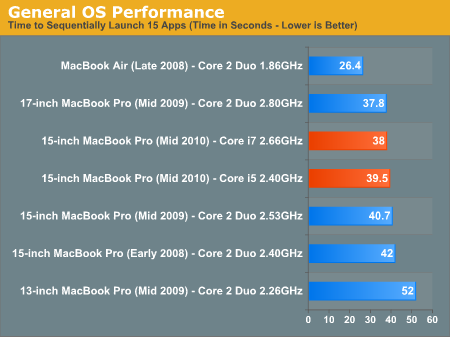
My application launch test absolutely rocks on the MacBook Air because it ships with an SSD by default. The MacBook Pros are stuck with mechanical hard drives and thus don’t perform nearly as well. If you’re curious, installing an Intel X25-M G2 in any of the MBPs will drop their times to 16 seconds or less.
The new MacBook Pro also doesn’t improve performance that much. I measured a 3% increase in performance, which although repeatable, isn’t really spectacular. This is compared to the old 2.53GHz Core 2 Duo and should serve as a baseline for the minimum performance improvement you should see. In other words, the 2.4GHz 15-inch MacBook Pro should perform no worse than last year’s 2.53GHz model.
The $2199 model with a Core i7 running at 2.66GHz pushes performance up another 3.9% over the base model. That's actually more than I expected but the real strength of the i7 is visible in the more CPU bound tests.
Adobe Photoshop CS4 Performance
The Retouch Artists Speed Test we use for our CPU testing under Windows also works under OS X. We're running the exact same benchmark here, basically performing a bunch of image manipulations and filters and timing the entire process.
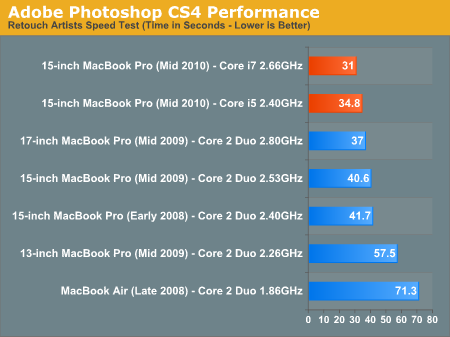
The old 13-inch MacBook Pro is penalized by only shipping with 2GB of memory, which is why it performs so poorly here. The real comparison is between the 2.4GHz Core i5 vs. the 2.53GHz Core 2 Duo from last year. The former is 16.6% faster in our Photoshop test. In fact, the new 15-inch MacBook Pro is even faster than the older 2.80GHz 17-inch model I reviewed.
The Core i7 model is 12.3% faster than the baseline Core i5 2.40GHz. Definitely noticeable.
Aperture 2 RAW Import
For my Aperture test I simply timed how long it took to import 203 12MP RAW images into the library.
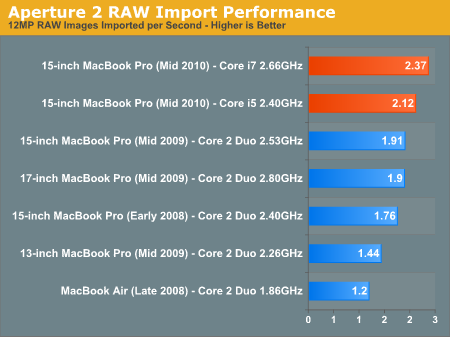
The new entry level 15-inch MBP is 10.9% faster than the old MacBook Pro, and again, it’s faster than the old 17-inch model as well. Moving to the Core i7 gives you another 11.8%.
Cinebench R10
I’m a fan of the Cinebench test because it lets me show off both single and multithreaded performance in the same workload. First, the single threaded performance:
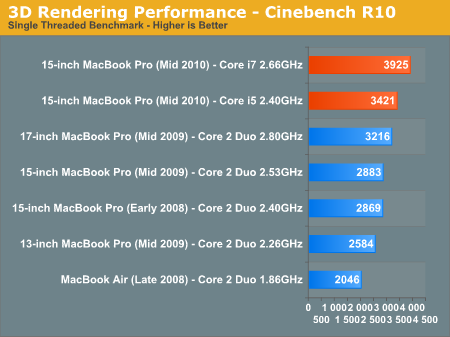
Here we have a huge advantage on the new MacBook Pro. Intel’s Turbo Boost is active here, resulting in a large performance advantage, not to mention all of the enhancements present in the Nehalem/Arrandale architectures. This is one of the best situations for the Core i7 vs. the i5. The extra $400 gives you another 14.7%, not bad at all.
Multithreaded performance is equally impressive:
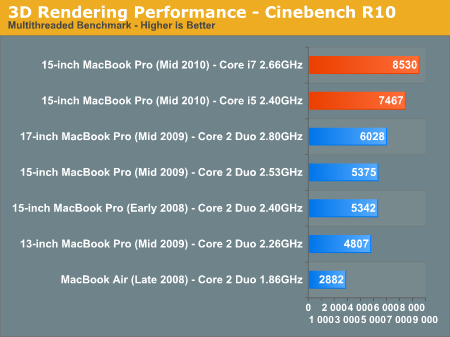
Thanks to Hyper Threading, the new Core i5 puts a generational gap between itself and last year’s MacBook Pro in this test. Whether you’re running single threaded or multithreaded applications, the Core i5 can be noticeably faster than the Core 2 Duo.
Quicktime H.264 Video Encoding
Our final benchmark is more consumer focused. Here I'm taking an XviD and converting it to an iPhone-supported H.264 format.
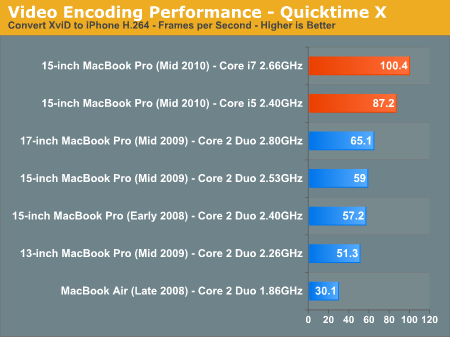
Video encoding is one of the i5’s definite strengths. If you do a lot of video encoding on your notebook, the jump from Core 2 to i5 is tremendous - approaching 50% in this case even despite the “lower” default clock speed. This is also the best showing for the Core i7 - count on an extra 15% over the base Core i5.
Core i7 vs. Core i5 Performance Summary
The two Core i5 models Apple offers ship with a 2.40GHz or 2.53GHz processor, both with a 3MB L3 cache. The $2199 15-inch MacBook Pro comes with a 2.66GHz Core i7, with a full 4MB L3 cache. Compared to the entry level model that's an 11% increase in clock speed and a 33% increase in L3 cache.
While I don't believe there's much reason to go for the 2.53GHz over the 2.40GHz model (L3 cache size remains the same, clock speed goes up by a small amount), the Core i7 is actually pretty decent. For a 22% increase in total system cost you end up with 11 - 15% better performance in CPU bound applications. It actually even feels snappier in general use as well.
I'd still suggest opting for an SSD before considering any CPU upgrades, but if you're looking to keep your new MacBook Pro for a while the Core i7 is worth it.










114 Comments
View All Comments
Rod Hagen - Thursday, April 15, 2010 - link
It is much, much easier on all of the unibody models than on the pre-unibody ones from before October 2008 (assuming this is what you had previous experience of) .Pretty much a five to ten minute job at worst in terms of the hardware side of things.
Cheers
Rod
MadMan007 - Thursday, April 15, 2010 - link
So I read this and I thought 'OK, Anand is impressed with the battery life' so I figured 'Hey why not see how it compares to other laptops?' I had to go to other articles because this review only has Macs - fair enough for the Mac fanbois who won't consider anything else anyway but not for those who might be open-minded. But what did I find? Sadly Windows laptops run an entirely set of battery test suites. 'Completely idle' 'Flash web browsing' (I think the Macs get a big boost by having non-Flash browsing and that seems like a big fudge to me) and then '720p video playback.'To my surprise, looking at results, the Macbook batery life is NOT super overwhelmingly impressive. Most of the other laptops that have high(er) battery life have CULV CPUs, fair enough they aren't as fast as the MacBook but then they will run any of the 'battery test' suites just as well. The recent Lenovo is however a Core i5 and gets good battery life.
So Anand, please stop the shenanigans with Apple battery life hype and use tests that are actually the same (as much as possible -Safair might not be available on Windows for example) across platforms.
Anand Lal Shimpi - Thursday, April 15, 2010 - link
I addressed the Windows comparison in some earlier articles, the most recent of which is here:http://www.anandtech.com/show/2870/done-for-2009-t...
You'll also note that Jarred runs an idle battery test in all of our Windows reviews, that's the most comparable to the light web browsing test. Some of the recent entries we've tested have gotten a lot better but take the Lenovo ThinkPad T410 for example:
http://www.anandtech.com/show/2976/lenovo-thinkpad...
With a 94Whr battery it delivers less battery life idle at the Windows desktop than this 77.5Whr 15-inch MBP while running our light web browsing test.
The gap is closing but it's still there. The first link shows that the gap only really exists in light load scenarios where there's lots of idle time (e.g. reading, web browsing, writing).
Take care,
Anand
maler23 - Thursday, April 15, 2010 - link
@MadMan007Hey dude, show a little respect. I can understand wanting a little perspective but maybe rephrase your request...unless it's a rant, in which case, flame on, sir :)
How about this:
=============
Anand, once you get all three models tested, could you include some comparison battery tests that include Flash as it that is a reality for most webpages(including the comment page I'm typing out right now). In addition, I would love to see a display comparison. I often see this site grumbling about contrast and color range and such with other laptops(recent Asus models, for example) but I would love to see Macbooks thrown into the bunch for comparison.
=============
cheers!
-J
Anand Lal Shimpi - Thursday, April 15, 2010 - link
I should also add that I do have a video playback and flash web browsing test for the MBP, they simply didn't make the final cut for yesterday's review due to time constraints however I'll be adding in the data in the next day or so :)Take care,
Anand
sky7i - Thursday, April 15, 2010 - link
Hmm, I was all set to get one but now I'm worried about heat and noise issues. I absolutely detest sweaty palms and am very sensitive to machine noise, often preferring my Acer netbook to the Mac as the Acer is silent.My current machine is an original Core Duo 15" MacBook Pro. It also has two fans (one a bit wobbly) but temperature wise it's fine. Will the new 15" be warmer?
I was also contemplating the SSD 128gb option for an extra $280, for the silence and performance. Will this help it run cooler? Is there a better option in that price range? The Intel SSD seems wonderful but it's $500. Maybe I'll just try to find a single-platter 250gb drive instead.
Thanks for any input.
solarisking - Thursday, April 15, 2010 - link
I have a late 2006 MBP and every since I had a warranty claim on the power brick (it stopped lighting orange/green/off correctly) they sent me a new one which was smaller. I think I figured out over time that it *seemed* like the new brick charged my MBP slower than the old one. Without the old brick I was unable to confirm. As it stands now, it can take up to 4 hours to charge the damn battery, if not longer. And I have two batteries! So hopefully, the new brick has more DC current and charges more quickly. Given a larger battery capacity that's my guess, and warmer laps are the result. And BTW, my MBP can get pretty dang hot when being recharged.laela - Thursday, April 15, 2010 - link
How is the battery life under Windows 7? Thanks for a great review!mikeev - Thursday, April 15, 2010 - link
I too would like to know this. I am extremely curious as to how bad the Windows 7 battery life is with that GPU cranking away the whole time, since I play a lot of games.Also, do you have any guess as to if NVIDIA or some 3rd party (a passionate user?) might possibly create a Windows driver/utility that will allow switching between the IGP and GPU like in OSX?
jasperjones - Thursday, April 15, 2010 - link
I think it's completely reasonable that Anand doesn't provide results for battery life under Win 7. iyam, if you don't use OS X as your primary OS, you shouldn't get a Mac. It's as simple as that.